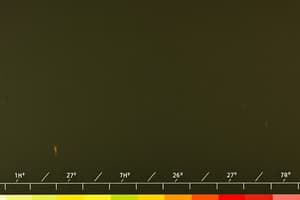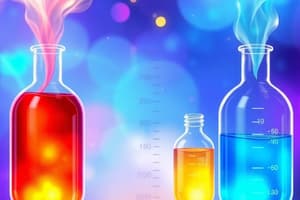Podcast
Questions and Answers
Explain why a solution with a pH of 3 has a higher concentration of hydrogen ions (H+) compared to a solution with a pH of 6.
Explain why a solution with a pH of 3 has a higher concentration of hydrogen ions (H+) compared to a solution with a pH of 6.
Because the pH scale is logarithmic, each unit decrease in pH represents a tenfold increase in hydrogen ion concentration. Therefore pH 3 has 1000 times more H+ ions than pH 6.
How do buffers like carbonic acid ((H_2CO_3)) help maintain pH balance in the blood?
How do buffers like carbonic acid ((H_2CO_3)) help maintain pH balance in the blood?
Buffers like carbonic acid maintain pH balance by absorbing excess hydrogen ions when the blood is too acidic or releasing hydrogen ions when the blood is too basic.
What type of reaction occurs when an acid and a base are mixed together, and what are the products of this reaction?
What type of reaction occurs when an acid and a base are mixed together, and what are the products of this reaction?
A neutralization reaction occurs. The products are a salt and water.
If a solution has a pH of 7, is it considered acidic, basic, or neutral? Explain your answer.
If a solution has a pH of 7, is it considered acidic, basic, or neutral? Explain your answer.
Why is maintaining a stable blood pH crucial for the proper functioning of living cells?
Why is maintaining a stable blood pH crucial for the proper functioning of living cells?
What is the difference between acidosis and alkalosis, and how do these conditions relate to blood pH levels?
What is the difference between acidosis and alkalosis, and how do these conditions relate to blood pH levels?
Describe what happens to an acid when it is dissolved in water, and what ion is released during this process.
Describe what happens to an acid when it is dissolved in water, and what ion is released during this process.
Explain how the concentrations of hydrogen ions (H+) and hydroxide ions (OH-) relate to each other in pure water.
Explain how the concentrations of hydrogen ions (H+) and hydroxide ions (OH-) relate to each other in pure water.
How do dehydration synthesis and hydrolysis relate to the formation and breakdown of polymers?
How do dehydration synthesis and hydrolysis relate to the formation and breakdown of polymers?
Why are proteins considered organic molecules, and what two elements must they contain?
Why are proteins considered organic molecules, and what two elements must they contain?
Explain the role of enzymes as functional proteins, providing an example.
Explain the role of enzymes as functional proteins, providing an example.
If a protein is composed of 15 amino acids, how many water molecules were removed during its synthesis?
If a protein is composed of 15 amino acids, how many water molecules were removed during its synthesis?
Describe the primary structure of a protein. What determines this structure?
Describe the primary structure of a protein. What determines this structure?
What distinguishes essential amino acids from other amino acids, and why is this difference important?
What distinguishes essential amino acids from other amino acids, and why is this difference important?
How do structural proteins like keratin and collagen contribute to the body's structure?
How do structural proteins like keratin and collagen contribute to the body's structure?
If a dipeptide bond is broken via hydrolysis, what reactants are required, and what products are generated?
If a dipeptide bond is broken via hydrolysis, what reactants are required, and what products are generated?
Explain how hydrogen bonding contributes to the secondary structure of a protein, and provide an example of a common secondary structure element.
Explain how hydrogen bonding contributes to the secondary structure of a protein, and provide an example of a common secondary structure element.
Describe how the tertiary structure of a protein is stabilized, and explain the significance of its globular shape.
Describe how the tertiary structure of a protein is stabilized, and explain the significance of its globular shape.
What is quaternary structure in proteins, and why is it important for some, but not all, proteins?
What is quaternary structure in proteins, and why is it important for some, but not all, proteins?
Relate the function of carbohydrates to the concept of energy storage, and explain the difference between the roles of starch and glycogen.
Relate the function of carbohydrates to the concept of energy storage, and explain the difference between the roles of starch and glycogen.
Describe the role of monosaccharides as the building blocks of carbohydrates. Give two specific examples of common monosaccharides and where they are found.
Describe the role of monosaccharides as the building blocks of carbohydrates. Give two specific examples of common monosaccharides and where they are found.
Explain the process of dehydration synthesis in the context of carbohydrate formation, and provide examples of disaccharides formed through this process.
Explain the process of dehydration synthesis in the context of carbohydrate formation, and provide examples of disaccharides formed through this process.
Compare and contrast the structures of starch and glycogen, highlighting how their structural differences relate to their functions.
Compare and contrast the structures of starch and glycogen, highlighting how their structural differences relate to their functions.
Describe the structural characteristics of cellulose, and explain why humans cannot digest it, even though it is composed of glucose monomers.
Describe the structural characteristics of cellulose, and explain why humans cannot digest it, even though it is composed of glucose monomers.
Explain why lipids provide more energy per gram than carbohydrates.
Explain why lipids provide more energy per gram than carbohydrates.
How do the structural differences between saturated and unsaturated fatty acids affect their physical state at room temperature?
How do the structural differences between saturated and unsaturated fatty acids affect their physical state at room temperature?
Describe the primary function of waxes in plants and animals, relating it to their molecular structure.
Describe the primary function of waxes in plants and animals, relating it to their molecular structure.
Explain the process of how a triglyceride is formed, naming the reactants and type of chemical reaction involved.
Explain the process of how a triglyceride is formed, naming the reactants and type of chemical reaction involved.
What is the purpose of hydrogenation of vegetable oils, and what type of fat is produced through this process?
What is the purpose of hydrogenation of vegetable oils, and what type of fat is produced through this process?
How does the structure of phospholipids contribute to their function in cell membranes?
How does the structure of phospholipids contribute to their function in cell membranes?
Compare and contrast the origins and compositions of fats and oils.
Compare and contrast the origins and compositions of fats and oils.
Describe how lipids contribute to the regulation of body temperature and the protection of internal organs.
Describe how lipids contribute to the regulation of body temperature and the protection of internal organs.
How does the hydrogenation process affect the structure and properties of oils, and what is a common byproduct of this process?
How does the hydrogenation process affect the structure and properties of oils, and what is a common byproduct of this process?
Explain why trans fats are considered 'abnormal' compared to cis fats, and provide an everyday example of a food item where trans fats are commonly found.
Explain why trans fats are considered 'abnormal' compared to cis fats, and provide an everyday example of a food item where trans fats are commonly found.
Describe how trans fats impact cholesterol levels in the body, and what potential health risk is associated with this impact?
Describe how trans fats impact cholesterol levels in the body, and what potential health risk is associated with this impact?
How do phospholipids differ in structure from triglycerides, and what is the significance of this difference in the context of cell membranes?
How do phospholipids differ in structure from triglycerides, and what is the significance of this difference in the context of cell membranes?
Describe the basic structure of steroids, and name two specific examples of steroids that are important in the human body.
Describe the basic structure of steroids, and name two specific examples of steroids that are important in the human body.
What are the three components of a nucleotide, and how do different nucleotides vary from one another?
What are the three components of a nucleotide, and how do different nucleotides vary from one another?
Distinguish between purines and pyrimidines in terms of their structure.
Distinguish between purines and pyrimidines in terms of their structure.
What is the primary function of ATP in cells, and how is energy released from this molecule?
What is the primary function of ATP in cells, and how is energy released from this molecule?
Flashcards
Acid
Acid
A compound that releases hydrogen ions (H+) when dissolved in water.
Base
Base
A compound that releases hydroxide ions (OH-) when dissolved in water.
pH Scale
pH Scale
A scale measuring the concentration of hydrogen ions (H+) in a solution.
Neutralization Reaction
Neutralization Reaction
Signup and view all the flashcards
Salt
Salt
Signup and view all the flashcards
Neutral Solution
Neutral Solution
Signup and view all the flashcards
Cellular Chemical Reactions
Cellular Chemical Reactions
Signup and view all the flashcards
Buffer
Buffer
Signup and view all the flashcards
Polymers
Polymers
Signup and view all the flashcards
Monomers
Monomers
Signup and view all the flashcards
Dehydration Synthesis
Dehydration Synthesis
Signup and view all the flashcards
Hydrolysis
Hydrolysis
Signup and view all the flashcards
Organic Molecules
Organic Molecules
Signup and view all the flashcards
Amino Acids
Amino Acids
Signup and view all the flashcards
Essential Amino Acids
Essential Amino Acids
Signup and view all the flashcards
Primary Structure of a Protein
Primary Structure of a Protein
Signup and view all the flashcards
Protein Secondary Structure
Protein Secondary Structure
Signup and view all the flashcards
Protein Tertiary Structure
Protein Tertiary Structure
Signup and view all the flashcards
Protein Quaternary Structure
Protein Quaternary Structure
Signup and view all the flashcards
Carbohydrate Function
Carbohydrate Function
Signup and view all the flashcards
Monosaccharides
Monosaccharides
Signup and view all the flashcards
Glucose
Glucose
Signup and view all the flashcards
Carbohydrate Dehydration Synthesis
Carbohydrate Dehydration Synthesis
Signup and view all the flashcards
Starch
Starch
Signup and view all the flashcards
Lipids
Lipids
Signup and view all the flashcards
Lipid Functions
Lipid Functions
Signup and view all the flashcards
Fatty Acids
Fatty Acids
Signup and view all the flashcards
Saturated Fatty Acids
Saturated Fatty Acids
Signup and view all the flashcards
Fats
Fats
Signup and view all the flashcards
Unsaturated Fatty Acids
Unsaturated Fatty Acids
Signup and view all the flashcards
Oils
Oils
Signup and view all the flashcards
Triglyceride
Triglyceride
Signup and view all the flashcards
Hydrogenation
Hydrogenation
Signup and view all the flashcards
Trans Fats
Trans Fats
Signup and view all the flashcards
Cis Fats
Cis Fats
Signup and view all the flashcards
Low Density Lipoproteins
Low Density Lipoproteins
Signup and view all the flashcards
Phospholipids
Phospholipids
Signup and view all the flashcards
Phospholipid Bilayer
Phospholipid Bilayer
Signup and view all the flashcards
Steroids
Steroids
Signup and view all the flashcards
Nucleotides
Nucleotides
Signup and view all the flashcards
Study Notes
Acids
- Acids are compounds that release hydrogen ions (H+) when dissolved in water through dissociation
- Acidic solutions have a pH less than 7
Bases
- Bases release hydroxide (OH-) ions upon dissociation in water
- Bases have a pH greater than 7
pH Scale
- The pH scale spans from 0 to 14, measuring acidity and alkalinity
- A pH of 7 is neutral, indicating a balance between acidity and alkalinity
- Common substances and their corresponding pH levels include:
- Battery acid: pH 0
- Stomach acid: pH 1
- Lemon juice: pH 2
- Vinegar: pH 3
- Black coffee: pH 5
- Pure water: pH 7
- Sea water: pH 8
- Baking soda: pH 9
- Ammonia solution: pH 11
- Bleach: pH 12
- Drain cleaner: pH 14
Salts
- Mixing an acid with a base results in a neutralization reaction producing salt and water
- Acid + Base = Salt + Water
- As an example, HCl + KOH → KCl + H₂O
- A salt is an ionic compound that dissociates into positive and negative ions, such as KCl → K+ + Cl-
Water and pH
- Water releases both H+ and OH- ions into solutions at equivalent concentrations
- The pH scale is used to measure the concentration of hydrogen ions in a given solution
- For each incremental decrease in pH, the hydrogen ion concentration increases tenfold
- pH 6 = 0.000001 M = 1 x 10-6 [H+]
- pH 5 = 0.00001 M = 1 x 10-5 [H+]
- pH 4 = 0.0001 M = 1 x 10-4 [H+]
- Pure water is neutral, so the [H+] = [OH-]
pH Functions in the Body
- Adequate blood pH must be maintained for such reactions to occur
- Living cells require chemical reactions for normal function
- Imbalances outside this optimal range can impede enzyme activity
- Normal blood pH is 7.4
- Alkalosis occurs at pH > 7.8
- Acidosis occurs at pH < 7
Buffers
- Buffers are chemicals which functions in the body to maintain a stable pH level
- Buffers work by:
- Counteracting excess acidity by taking up excess hydrogen ions
- Releasing hydrogen ions to counteract excess alkalinity
- In blood, carbonic acid (H₂CO₃) serves as a prevalent buffering agent
Studying That Suits You
Use AI to generate personalized quizzes and flashcards to suit your learning preferences.




